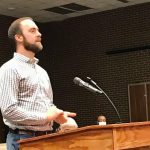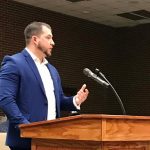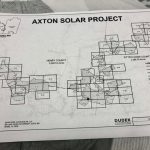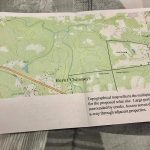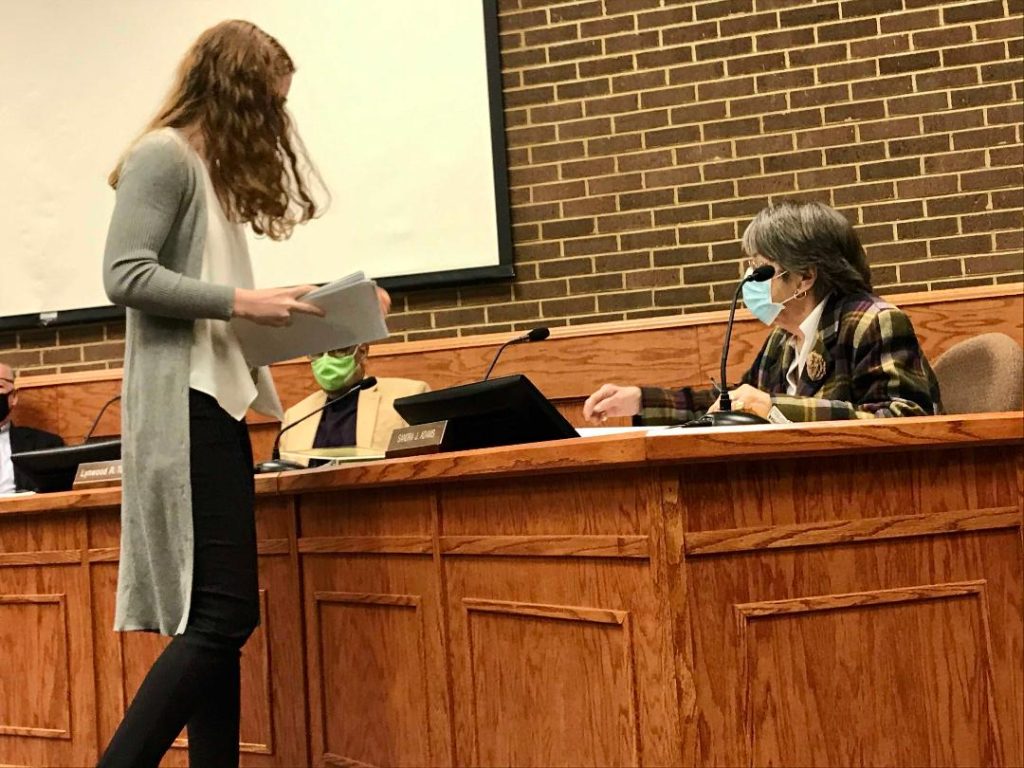
By Brandon Martin
The Henry County Board of Zoning Appeals held two public hearings on special use permits on proposed solar farms to be constructed in the Iriswood District.
Both projects would be divided between Henry and Pittsylvania counties.
While the board unanimously approved the special use permit for the first project, a decision was deferred on the second proposal to allow more time for communication between the applicant and adjacent property owners.
Michaux Solar Center, LLC
A 50-megawatt (MW) utility-scale solar energy generating facility being developed by Orsted Onshore North America was the first project discussed.
Ryan Gilchrist, director of development for Orsted, said the company was formerly known as Danish Natural Gas and Oil. Recently, the company divested all its assets in those energy sectors and has since become the largest owner of offshore wind, with plans to further expand into solar energy production.
“One thing I’ll say about the project is it is fully beneficial to the county,” Gilchrist said. “Solar projects are inherently low-impact. There is no noise, very little visual impact. At the same time, we are creating jobs by the several dozen during construction, as well as a few during operations. There is significant tax and lease revenue for the county without putting any stress on the county with the land itself.”
Gilchrist said solar panels maintain the integrity of the land.
“A lot of times, you have landowners who are looking to divest land, maybe with a younger generation that inherits it will try to sell it or do something with it,” Gilchrist said. “Solar allows them to keep it in the family for generations and actually have a sustainable revenue stream from it. In the long-term, solar can do a good job of maintaining the character of the land.”
Jamie Mears, the project developer, said the total land area for the project will be 600 acres.
She said the 50 MWs are “predicted to power approximately 10,000 homes annually.”
Mears said the project will also bring in $640,000 annually to both participating counties, with a 50/50 split in revenue.
Gilchrist said the revenue would be broken down further into a 50/50 split between the lease and taxes. At 25 percent, it would mean $160,000 in taxes for the county.
“The only tax revenue that I’m aware of that Henry County would realize is in regard to the loss of the land-use taxation status of the properties that are being used for the solar panels,” said Lee Clark, director of planning and zoning. “Help me understand what other tax revenues the county will realize because it’s my understanding that we don’t have the authority to tax the panels themselves.”
Gilchrist said only one part of the equation is the change in land-use status.
“Primarily, it is the tax on the equipment itself,” Gilchrist said. “Solar is classified as machinery and tools. There is legislation that passed last year that increased the tax on solar. It used to be you’d only reap 20 percent of that benefit, but now it steps up to 30 percent after five years.”
Besides tax benefits to the county, property owners also would benefit.
Olivia Vipperman Wilson, a landowner participating in the project, said her family is looking forward to the project.
“My family purchased our parcel of property as an investment for my husband and I, maybe part of our retirement, but also for our children to have something to lean back on in the future as well,” she said. “When this opportunity presented itself, we did consider it quite a blessing because it will be able to significantly help our family for a long time. If it can provide for my family, the county and other residents then I think it will be a really good project.”
Before that can happen, Clark said a few additional requirements would need to be met before issuing a building or land disturbing permit.
“The chain link fence is one thing but that doesn’t really provide what I think, if I were an adjoining property owner, what I would want to see out there,” Clark said. “I want the fencing to be at a height that is at least equal to the panel heights once they are installed. I think that fencing ought to be made opaque, in that it should be like a privacy fence.”
Clark said he would like to see the fencing installed anywhere “there is an adjacent road or residence.”
Another aspect Clark focused on was the decommissioning plan. In documents provided to the board, the developers anticipated making a profit from removing the solar panels at the end of the project. By comparing the estimated price of removal ($2.6 million) to the total salvage and resale value ($3.4 million), the developers expect to make $421,291 by recycling the materials.
“I have a hard time accepting their numbers in that they are actually saying they are going to make more off of the decommissioning of that site than it cost to remove it,” Clark said. “You’re assuming that they know the value of the materials would be 35 years from now. I don’t have a crystal ball. I don’t know what the value of those materials will be.”
Before issuing the necessary permits, Clark requested either a “performance bond, letter of credit, or some other acceptable guarantee” that covers the cost of removing the panels “should something happen to this company” before the end of the project.
Additional requirements are “the site shall be maintained in compliance with standards contained in applicable federal, state, local building codes, and erosion and sedimentation control standards and regulations; existing mature tree growth and natural landforms on the site shall be preserved to the maximum extent possible” and following other applicable requirements.
The Henry County Board of Supervisors also must consider approving the permit. Axton Solar, LLC
The second project, through the developer Vesper Energy, would construct a 200 MW solar energy facility across 21 discontinuous privately-owned parcels in Henry County. It would also include 16 parcels in Pittsylvania County.
Trey Lopez, the assistant development manager, said a little over half of the project would be in Henry County. He added that 50 percent of the property taxes would also go to the county.
“Based on initial estimates over 35 years, we are looking at an average of $200,000 per year going to the county in additional property tax revenue,” Lopez said. “It’ll bring in additional construction jobs with approximately 12-14 months of construction. There will be additional revenue from those individuals purchasing food, hotels and that sort of thing.”
He said construction for the project is currently set to begin between October and December 2022, with an operational date in December 2023.
Jonathan Puvak, legal counsel for the project, said more acreage would be obtained than needed for actual usage.
“Another significant benefit to this project for the county is that given its size ━ 200 MW ━ that is above what the General Assembly has done in terms of state tax exemption,” Puvak said. “That exemption only applies to projects that are below 150 MW. When you have a project like this, they are paying full freight for taxes.”
He said this included full freight on machinery and tools, as well as real property tax.
“If you take property like this 1,200-acres, it’s not unusual to see that property become reassessed with solar panels up to” $12,000 an acre, Puvak said. “It’s hard to find that kind of economic development opportunity that has no impact on county services.”
Puvak said before obtaining building permits, the developers would submit a decommissioning plan with “some sort of adequate security,” that would include a five-year refresher to reassess the value of salvageable materials.
He said it would be like “the applicant shall submit the decommissioning plan prior to the building permit. The decommissioning plan submitted by the applicant shall include adequate security to the benefit of Henry County in the amount of the estimated decommissioning cost. The applicant shall agree to update the decommissioning cost estimate on a five-year basis during the life of the project and the decommissioning security shall be provided to the county prior to when the building permit is issued.”
Will Vaughn, president of J&R Management, spoke in support of the project.
“It’s a very rural stretch of property bordered by (U.S. Route) 58, Stoney Mountain Road and there are some residential neighbors but it’s very rural,” Vaughn said. “As a local person, and representative of a local landowner, we are very much in favor of this. In terms of tax and rent benefits but also in terms of green energy. I think that is good for all of us.”
Constance Martin Florence, another nearby landowner, said she is surrounded by solar panels in her residence in North Carolina.
“My light bill is $23 a month,” she said. “I’m not trying to tell you all what to do or what not to do, but I’m just letting you know that I have solar panels on my house and not far from where I live, there is a farm. My light bill is dirt cheap.”
While some spoke in favor of the project, the most community feedback came from those who were either partially opposed or that didn’t know enough about it to decide.
Bill Oliver, a nearby landowner, said he agrees with green technology, but objects to “the portion of the property that borders our 80-acre farm” due to permanent destruction of virgin forest, the property being less suitable for a solar farm, changes in noise and wind patterns, displacement of wildlife and property devaluation.
“The entire property in question is covered by timber,” Oliver said. “There is no open property on this particular piece of land. Many creatures live on this property including deer, fox, bear, coyote, bald eagles, owls and a host of other creatures who are reliant on the self-sustaining woodland that it is a part of.”
His wife, Beth, said “I have ridden on the property for years. I understand the creeks, the valleys, and the rock outcroppings. It bothers me that someone is going to bring equipment in to try and build this across these creeks.”
The most opposition came from landowners who said they didn’t receive enough notice about the project.
Joyce Bennett, an adjacent landowner, said she felt blindsided by the news of the project.
“This is all new to me. I have no idea what this is about,” she said. “I’m not really against the solar if it’s somewhere else. I just got this (notice) a week ago. I know nothing about it. I can’t really say if I’m for it or against it because I know nothing about it.”
Freddy Williams, another adjacent landowner, added that “somebody must have failed somewhere because with this short notice that we got, it seems like there should have been more of a notice than two weeks ago.”
Clark said that the applicants are required to have a community meeting months in advance of the board meeting.
“The way they conducted their public meetings, because of COVID, was online over Zoom,” Clark said, adding that the county received many phone calls after they published the public hearing notice.
Given the number of property owners that felt the application was rushed, the board agreed to defer making a judgment on the special use permit until their Feb. 24 meeting. There will not be another public hearing and the next meeting on the project will only be informational.




